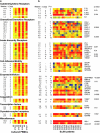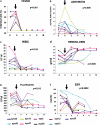Role of interleukin-1 (IL-1) in the pathogenesis of systemic onset juvenile idiopathic arthritis and clinical response to IL-1 blockade
- PMID: 15851489
- PMCID: PMC2213182
- DOI: 10.1084/jem.20050473
Role of interleukin-1 (IL-1) in the pathogenesis of systemic onset juvenile idiopathic arthritis and clinical response to IL-1 blockade
Abstract
Systemic onset juvenile idiopathic arthritis (SoJIA) encompasses approximately 10% of cases of arthritis that begin in childhood. The disease is unique in terms of clinical manifestations, severity of joint involvement, and lack of response to tumor necrosis factor blockade. Here, we show that serum from SoJIA patients induces the transcription of innate immunity genes, including interleukin (IL)-1 in healthy peripheral blood mononuclear cells (PBMCs). Upon activation, SoJIA PBMCs release large amounts of IL-1beta. We administered recombinant IL-1 receptor antagonist to nine SoJIA patients who were refractory to other therapies. Complete remission was obtained in seven out of nine patients and a partial response was obtained in the other two patients. We conclude that IL-1 is a major mediator of the inflammatory cascade that underlies SoJIA and that this cytokine represents a target for therapy in this disease.
Figures





Comment in
-
Research on human subjects in the JEM.J Exp Med. 2005 May 2;201(9):1349-50. doi: 10.1084/jem.20050723. J Exp Med. 2005. PMID: 15867088 Free PMC article. No abstract available.
References
-
- Cassidy, J.T., and R.E. Petty. 2001. Textbook of Pediatric Rheumatology. W.B. Saunders, Philadelphia, PA. 976 pp.
-
- Wallace, C.A., and J.E. Levinson. 1991. Juvenile rheumatoid arthritis: outcome and treatment for the 1990s. Rheum. Dis. Clin. North Am. 17:891–905. - PubMed
-
- Ravelli, A., and A. Martini. 2003. Early predictors of outcome in juvenile idiopathic arthritis. Clin. Exp. Rheumatol. 21:S89–S93. - PubMed
-
- Modesto, C., P. Woo, J. Garcia-Consuegra, R. Merino, M. Garcia-Granero, C. Arnal, and A.M. Prieur. 2001. Systemic onset juvenile chronic arthritis, polyarticular pattern and hip involvement as markers for a bad prognosis. Clin. Exp. Rheumatol. 19:211–217. - PubMed
-
- Ravelli, A. 2004. Toward an understanding of the long-term outcome of juvenile idiopathic arthritis. Clin. Exp. Rheumatol. 22:271–275. - PubMed
Publication types
MeSH terms
Substances
Grants and funding
LinkOut - more resources
Full Text Sources
Other Literature Sources
Medical

